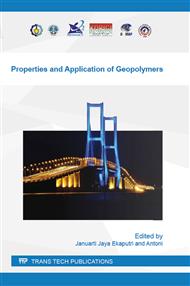[1]
A. Elimbi, H. T., & Njopwono, D. (2011). Effect of Calcination Temperature of Kaolinite Clays on The Properties of Geopolymer Cements. Constructions & Building Materials, 2805-2812.
DOI: 10.1016/j.conbuildmat.2010.12.055
Google Scholar
[2]
Bernal et al. (2012). Performance of Refractory Aluminasilicate Particle/Fiber Reinforced Geopolymer Composite. Composite : Part B, 9191-(1928).
Google Scholar
[3]
Daniel L.Y. Kong, ,. J. (2008). Damage Behaviour of Geopolymer Composites Exposed to Elevated Temperatures. Cement and Concrete Composites.
DOI: 10.1016/j.cemconcomp.2008.08.001
Google Scholar
[4]
Jian He, Y. J. (2012). Synthesis and Caracterization of Red Mud and Rice Husk Ash-Based Geopolymer Composite. Cement & Concrete Composite , 108-118.
DOI: 10.1016/j.cemconcomp.2012.11.010
Google Scholar
[5]
K. Pimraksa, P.C., & A. Rungchet, K. S. C. (2011). Lightweight Geopolymer made of highly porous siliceous materials various Na2O/Al2O3 and SiO2/Al2O3 ratio. Materials Science and Engineering A, 6616-6623.
DOI: 10.1016/j.msea.2011.04.044
Google Scholar
[6]
Khan Irfan, et al. (2014). Sodium Silicate Free Geopolymer As Coating Material: Adhesion to Steel. 1st International Electronic Confrence on Material.
DOI: 10.3390/ecm-1-b016
Google Scholar
[7]
M.S. Siti Salwa, A.M., & H. Kamaruddin, C. R. (2013). Review on Current Geopolymer as a Coating Material. Australian Journal of Basic and Science, 7(5): 246-257.
Google Scholar
[8]
Rovnanik*, P. (2010). Effect of Curing Temperature on The Development of Hard Structure of Metakaolin-based Geopolymer. Construction and Building Materials , 1176-1183.
DOI: 10.1016/j.conbuildmat.2009.12.023
Google Scholar
[9]
Sata vanchai, S. Apha & C. Prinya. (2012). Resistance of Lignite Bottom Ash Geopolymer Mortar to Sulfate and Sulfuric Acid Attack. Cement and Concrete.
DOI: 10.1016/j.cemconcomp.2012.01.010
Google Scholar
[10]
Silva P. D, K. S. -C. (2007). Medium-Term Phasem Stability of Na2O-Al2O3-SiO2-H2O Geoplolymer System. Cement Concrete Research, 870-876.
DOI: 10.1016/j.cemconres.2007.10.003
Google Scholar
[11]
Subaer. 2012. Pengantar Fisika Geopolimer. Makassar: BP Universitas Negeri Makassar.
Google Scholar
[12]
Temuujin Jadambaa, A. M., & William Rickard, M. L. (2009). Preparation of Metakaolin based Geopolymer Coatings on Metal Substrates as Thermal Barriers. Applied Clay Sciences, 46, 265-270.
DOI: 10.1016/j.clay.2009.08.015
Google Scholar
[13]
Temuujin Jadambaa, A. M., & William Rickard, M. L. W. Lestyn, A. V Riessen. (2010). Fly Ash Based Geopolymer Thin Coatings on Metal Substrates and Its Thermal Evaluation. Journal of Hazardous Materials , 748-752.
DOI: 10.1016/j.jhazmat.2010.04.121
Google Scholar


